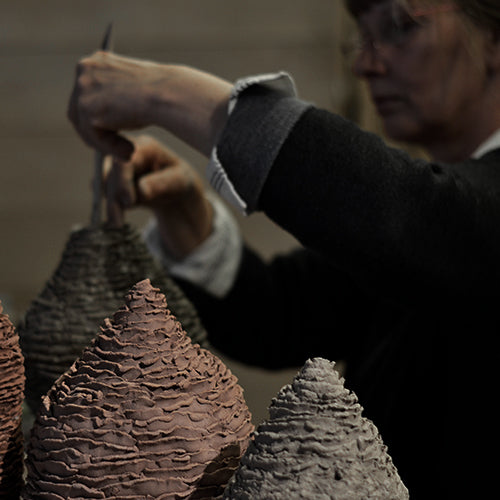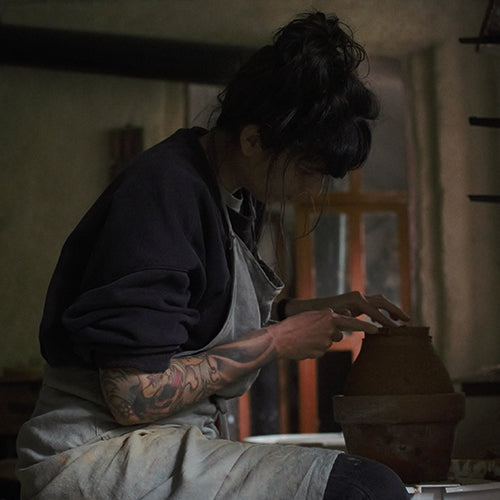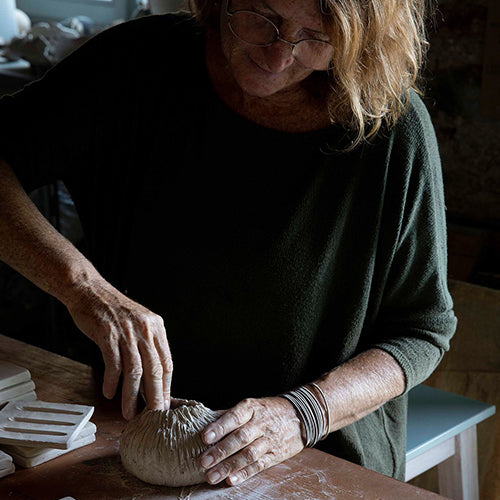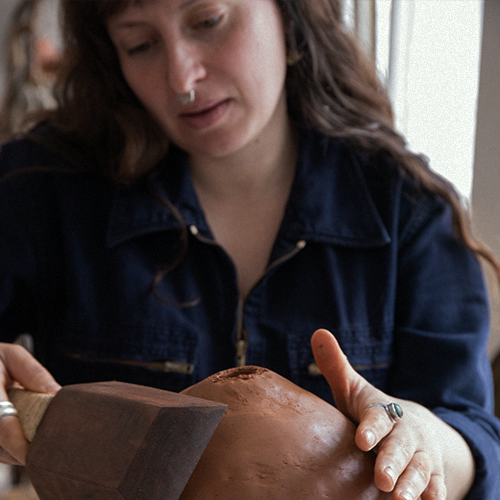Wild Clay
Wild Clay
Places, roots and memories
21 settembre - 12 ottobre 2024
21 settembre: h16.00 Demonstrative and interactive talk — h18.00 Opening

There is a French term, terroir, that is used in wine matters. It indicates the relationship between a grape variety, the climate and the surrounding geology. What if there is a similar word for us humans as well? How much does geology influence the way we are, live, build, believe, inhabit? How does it shape the history and legends of places?These reflections are the starting point for “Wild Clays. Places, roots and memories,” an exhibition that unites five ceramists, with the extraordinary participation of Lidia Boševski, united by a strong bond with the land and the territory, but each with a personal artistic path and creative approach. ‘Holding these ceramics in my hands,’ Elena Salamon explains, ”gives me powerful sensations. You want for the “roughness,” for the colors of the earth, for the history they contain. I strongly wanted to set up this exhibition because I think it's really fascinating and rare that, in these hectic times, there are people who still experiment, artists who don't worry about how many weeks or months it takes to create, weeks and months that for them are a pleasure and that they don't necessarily quantify economically. In fact, quantifying economically how much time the wild clay process demands is practically impossible.”

The first step in working with wild clays is to study the terrain. Once a suitable location has been identified, the clay is gathered by hand, on foot in the woods, among small streams, up hills or at high altitudes, and then allowed to dry. Clay in fact needs to rest before it can be successfully shaped, and this step, depending on weather conditions, can take up to weeks. When the clay is dry, it can be sifted several times or left as a whole. Now begins the testing phase to find out whether the material is plastic and, more importantly, whether it can withstand baking and up to what temperature. This phase is a continuous discovery, an endless experiment that each time brings immense joys, but also great frustrations and failures. If the clay passes all these tests, it can be used to create objects with the most diverse techniques or still processed and combined with ashes and other components to make a glaze.
Narrating this long process live and with their works will be Giulia Forgione, Maddalena Boero, Francesca Pamina Ros and Jesse Donham-Buratti.
Lidia Boshevski
Lidia Boševski is a Croatian ceramicist who works exclusively with wild materials, inspired by nature, its textures, structures and forms. A graduate of the Zagreb School of Applied Arts and a graduate of the Faculty of Textile Technology, in the early 1990s she began exploring painting using various graphic techniques, and since 2002 her interest has turned to ceramics. After opening the Owl atelier in her hometown in 2005, she expanded her approach to art and design by studying and using mainly local natural materials. Dozens of solo and group exhibitions, including Croatia, Italy, Austria, the United Kingdom, Canada and China, testify to the artist's significant output. He is a member of several national associations of artists in Croatia. “Nature is a real wealth, an inexhaustible source of inspiration and my best teacher. There is always something unexpected, something new, which gives me inspiration for further elaboration. The use of clay, materials and all other local elements connects me to the place where I collect them, which contains enormous evidence of all the changes (that have taken place over millions of years) and is in a constant process of transformation. My approach is to always try to understand what these elements have to offer me and how I can work with them. Celebrate your local materials, which are your natural heritage. It is a never-ending journey.”
Giulia Forgione
Giulia Forgione is a ceramist and anthropologist who works with local clays, rocks and waste materials. The search for materials in nature is slow, on foot in the woods, among small streams and up the hills, just as her making ceramics is slow. A production possible only after numerous tests and experiments that take into account the infinite diversity of the properties of the materials. High-temperature firing allows for the creation of durable and resistant works and, at the same time, to observe a correspondence between the ceramic process and the rock formation phenomena that occur inside the magma chambers, the feeding basins of volcanoes. Just as natural phenomena never reproduce themselves identically, producing ceramics with collected local materials means learning to accept a wide margin of variability: everything changes and nothing is reproducible identical to itself. "Matter is the central point of my research. The collection of local materials connects me deeply not only to the territory I live in, but also to the processes that govern the incessant motion of things. Even if we don't see it, a rock changes, becomes clay, which then perhaps becomes rock again. It makes me feel closer to these mysterious processes. Making ceramics is having the privilege of imitating how a volcano works. The geological perspective, the point of view of the Earth, puts us in front of the incredible force that sustains us and also the blink of an eye that is our existence. Dealing with the mineral world questions me about who I am in relation to this miracle that is the creation of things, of rocks, of waters».
Maddalena Boero
Maddalena Boero is a geologist and ceramist, she has lived in various Italian cities and abroad, where she has followed ceramic workshops and collaborated with other artists and creatives. For the Valpiana social cooperative, since 2019 she has organized educational courses in which ceramics have the function of an extraordinary therapeutic medium. Fascinated by the beneficial power of art on people, the following year she attended the Artedo art therapy school in Turin and obtained the certificate in Creative art therapy laboratory. She has held solo and group exhibitions in Italy and abroad. Since 2022 she has lived in the Piedmont countryside, where she has renovated two eighteenth-century farmhouses trying to respect their original design and structure. Here she has moved her ceramic laboratory and carries out a project of cultural events that hosts and attracts people from all over the world. «Working with local clay, the one collected in the area near where I live, and transforming it into fired works has a meaning of great strength for me. In the act of collecting there is a clear desire to find “roots”, the historical-geological ones of the created vase and my own that the earth has guarded and embodied for very long times in its grains of clay. And so in the space of my laboratory I shape, create and feel a bit like a disseminator of memories preserved for people, for the world».
Francesca Pamina Rose
Francesca Pamina Ros she met ceramics in 2011, at the same time as her classical and humanist studies. In fact, she combines ceramics with work in a publishing house, dealing with illustrated albums and children's books. She trained with Italian and international master ceramists, experimenting with ever-different techniques and approaches: Elena D'Oria and Giorgio Fasano, Rossana Gotelli, Mirco Denicolò, Robert Cooper, Patricia Shone, Terry Davies and Lidia Boševski, among others. She works mainly on the wheel and slab, with stoneware and "wild" or "urban" clays, collected in the neighborhood where she lives and in the woods between Piedmont and Liguria. "I have always been emotionally connected to the neighborhood where I live in the city, but also a tireless walker in the woods. The clays I collect are therefore “urban” because they come from the excavations of Borgo Dora that have taken place over the years, given to me in small quantities by the workers who worked on the construction sites and who smiled but satisfied my bizarre request. And they are also “wild” and “sarvæghe” (in Genoese) because they are collected during excursions just outside Turin and Genoa, the places where I have lived the longest. Wild materials give me the opportunity to continually test myself: clay, to be worked on a slab or on a lathe, in fact requires a particular plasticity that is difficult to find “ready” in nature; consequently the results I aspire to are a very difficult compromise between my search for perfection and the limits, mine and those of non-commercial lands».
Jesse Donham Buratti
Jesse Donham-Buratti is a ceramist and agroecologist who works with wild materials. She has lived her whole life between two places and two languages, between Italy and California, and after a three-year degree in Environmental and Political Sciences she moved to Melbourne, Australia. Here she began to experiment with clay in a self-taught way, first working on the wheel and then dedicating herself to manual techniques. She discovered and deepened the practice of "wild clay" by training with true pillars of this approach, such as Nina Salsotto Cassina, Anja Slapnicar and Studio Alluvium. «I collect small quantities of clay during excursions, swimming, in agricultural land, and then test them numerous times, adding rocks and minerals to recreate a sort of landscape on each work. My vases are almost always left unglazed to show the essence of the earth, its cracks and lines, and all are fired at high temperatures, to push the materials to their limits, simulating a very long geological process in a few hours. For a long time, ceramics have been relegated to everyday life, to the creation of necessary and functional objects, practiced for millennia without calling it art. When I work, I think above all of the hands of women who over time have shaped, rolled, cut and designed the ceramics that for me are works of art. Each of my vases bears the name of a woman in history, forgotten over time. Working only by hand, each work is unique and impossible to replicate, both because of the manual construction process and the limited amount of clay that can be collected in each place».






